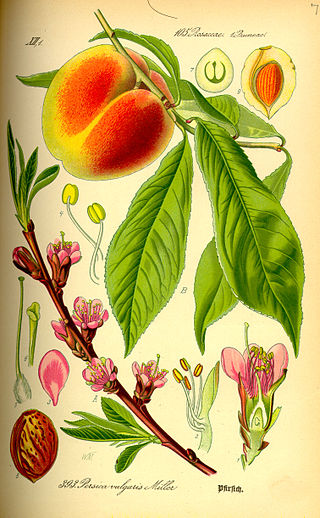
The peach is a deciduous tree first domesticated and cultivated in Zhejiang province of Eastern China. It bears edible juicy fruits with various characteristics, most called peaches and others, nectarines.

An apricot is a fruit, or the tree that bears the fruit, of several species in the genus Prunus.

A plum is a fruit of some species in Prunus subg. Prunus. Dried plums are most often called prunes, though in the United States they may be just labeled as 'dried plums', especially during the 21st century.

The cherry blossom, or sakura, is the flower of trees in Prunus subgenus Cerasus. "Sakura" usually refers to flowers of ornamental cherry trees, such as cultivars of Prunus serrulata, not trees grown for their fruit. Cherry blossoms have been described as having a vanilla-like smell, which is mainly attributed to coumarin.

Prunus spinosa, called blackthorn or sloe, is a species of flowering plant in the rose family Rosaceae. The species is native to Europe, western Asia, and regionally in northwest Africa. It is locally naturalized in New Zealand, Tasmania, and the Pacific Northwest and New England regions of the United States.
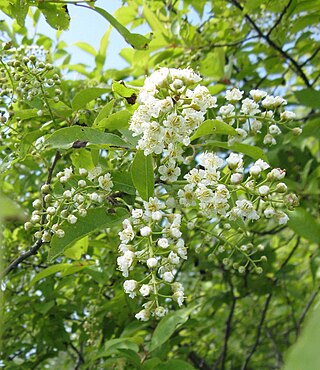
Prunus virginiana, commonly called bitter-berry, chokecherry, Virginia bird cherry, and western chokecherry, is a species of bird cherry native to North America.
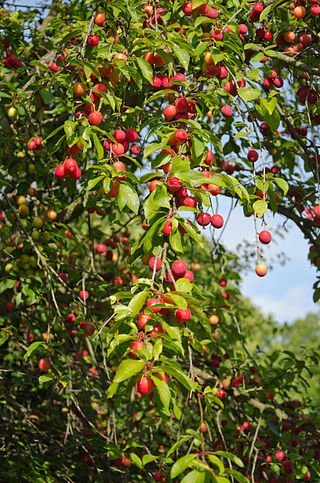
Prunus cerasifera is a species of plum known by the common names cherry plum and myrobalan plum. It is native to Southeast Europe and Western Asia, and is naturalised in the British Isles and scattered locations in North America. Also naturalized in parts of SE Australia where it is considered to be a mildly invasive weed of bushland near urban centers. P. cerasifera is believed to one of the parents of the Cultivated Plum, Prunus domestica perhaps crossing with the sloe, Prunus spinosa, or perhaps the sole parent. This would make it a parent of most of the commercial varieties of plum in the UK and mainland Europe - Victoria, greengages, bullace etc.

Prunus salicina, commonly called the Japanese plum or Chinese plum, is a small deciduous tree native to China, Taiwan and Southeast Asia. It is an introduced species in Korea, Japan, Israel, the United States, and Australia.

Prunus pumila, commonly called sand cherry, is a North American species of cherry in the rose family. It is widespread in eastern and central Canada from New Brunswick west to Saskatchewan and the northern United States from Maine to Montana, south as far as Colorado, Kansas, Indiana, and Virginia, with a few isolated populations in Tennessee and Utah. It grows in sandy locations such as shorelines and dunes.

Prunus nigra, the Canada plum, Canadian plum, or black plum, is a species of Prunus native to eastern North America.

Prunus americana, commonly called the American plum, wild plum, or Marshall's large yellow sweet plum, is a species of Prunus native to North America from Saskatchewan and Idaho south to New Mexico and east to Québec, Maine and Florida.

Prunus tomentosa is a species of Prunus native to northern and western China, Korea, Mongolia, and possibly northern India. Common names for Prunus tomentosa include Nanjing cherry, Korean cherry, Manchu cherry, downy cherry, Shanghai cherry, Ando cherry, mountain cherry, Chinese bush cherry, and Chinese dwarf cherry.
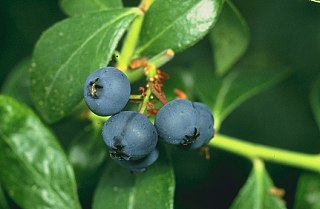
Blueberry is a widely distributed and widespread group of perennial flowering plant with blue or purple berries. They are classified in the section Cyanococcus within the genus Vaccinium. Vaccinium also includes cranberries, bilberries, huckleberries and Madeira blueberries. Commercial blueberries—both wild (lowbush) and cultivated (highbush)—are all native to North America. The highbush varieties were introduced into Europe during the 1930s.

Prunus avium, commonly called wild cherry, sweet cherry or gean is a species of cherry, a flowering plant in the rose family, Rosaceae. It is native to Europe, Anatolia, Maghreb, and Western Asia, from the British Isles south to Morocco and Tunisia, north to the Trondheimsfjord region in Norway and east to the Caucasus and northern Iran, with a small isolated population in the western Himalaya. The species is widely cultivated in other regions and has become naturalized in North America, New Zealand and Australia.
Prunus eremophila, also known by its common name Mojave Desert plum, is a rare species of plum native to California.

Prunus angustifolia, known commonly as Chickasaw plum, Cherokee plum, Florida sand plum, sandhill plum, or sand plum, is a North American species of plum-bearing tree. It was originally cultivated by Native Americans before the arrival of Europeans. The species' name angustifolia refers to its narrow leaves. It became the official state fruit of Kansas in 2022.
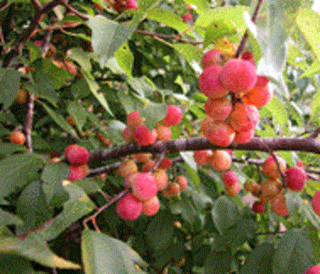
Prunus rivularis, known variously by the common names creek plum, hog plum, or wild-goose plum is a thicket-forming shrub. It prefers calcareous clay soil or limestone-based woodland soils. This deciduous plant belongs to the rose family, Rosaceae, and is found mainly in the central United States. It is a shrub consisting of slender stems with umbel clusters of white blossoms. The fruit is a drupe that resembles a large berry; though it has a bitter taste, it serves as a source of food for birds and other wildlife. "Prunus" is Latin for plum, whereas "rivularis" means being near a stream.
Prunus persica × Prunus americana is the hybrid between the peach Prunus persica and the wild American plum Prunus americana.

Prunus simonii, called apricot plum and Simon plum, is a tree in the genus Prunus. It was first described by Elie-Abel Carrière in 1872 and is native to Hebei province, China. The species is not known in a truly wild state. It has been important for breeding commercial plum cultivars from crosses with other species of the genus Prunus. The species is named for Gabriel Eugène Simon (1829–1896), a French botanist and diplomat who sent pits to the Paris Museum in the early 1860s while he was representing the French government in China. Beginning about 1881, the species became commonly known in the United States; having been introduced there from France.
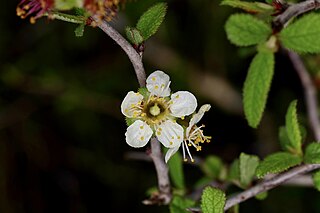
Prunus texana, called peachbush, Texas almond cherry, Texas peachbush, sand plum, peach bush, duraznillo and wild peach is native to central and western Texas. Although it looks like peach, it actually belongs to Prunus sect. Prunocerasus together with other North American plum species.
























